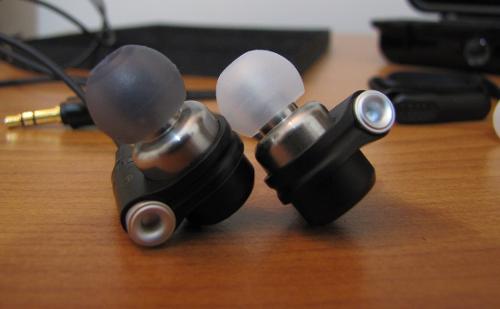Full review here:
LINK
 Specifications
Specifications:
Drivers: 2 x Dynamic 10mm + Dual Balanced Armature
Frequency range: 10 Hz-40 KHz
Impedance: 10Ω
Sensitivity: 106±2dB
Connection: 3.5mm Gold-plated
Cable: 1.2m
Weight: 24g
Price (MSRP):
U$D 380
Accessories: (4/5)
Build & Design: (5/5)
Fit, Comfort, Isolation: (4/5)
Sound:
This time the new Dunu hybrid takes a dual dynamic + dual BA configuration, unlike their three previous hybrid model ones which had only one dynamic along the dual BA small Knowles TWFK drivers. These two dynamic are not smaller drivers but 10mm like the previous ones. After having the DN-1000 and DN-2000 for a long time already with their strong bass response, I had my doubts about the new tuning of this last one. Dunu's IEMs are not bass heavy by default, the Titan series can prove that, and dual DDs doesn't necessary equals to powerful bass either, but warm sounding they truly are, and both other triple hybrids had more than enough. To my surprise the DN2002 turned to be quite an amazing earphone, probably the best tuned of all the Dunu IEMs I've tried, and one of the most balanced and good sounding universal earphones regardless their price. Moreover, the DN-2002 hybrid results are among the best in terms of coherence between drivers type and play along in beautiful unison. The DN-1000 had that notorious incoherence, and even the 2000, while much better, wasn't free of this issue. Unfortunately, I can't comment about the 2000J as I never got a chance to try it, but the Fidue A73 (1DD+1BA) was an excellent example of a coherent hybrid, that could match the DN-1000 in many technical aspects.
Now, as for the DN-2002 itself; starting from the low end it is very accurate with excellent control, in a very higher dynamic driver style, with great detail and well textured. It's very full in body but not overly thick, solid in note presentation and very resolving in the sub-bass region. The DN-2002 remains very clean and shows no hint of bloat, which is quite an achievement for a Dunu product with this strong bass response. While the sub-bass reach is not as deep as the DN2000, or as immersive or addicting, with this new dual dynamic setup the lowest frequencies are faster and more effortless. I'm not aware of the inner configuration of these two drivers but they play along very well. Tonally, the bass keep the typical Dunu's house warm and rich signature with enough emphasis but definitely sounds more neutral and realistic, what makes it easier to enjoy even at higher volumes. As for bass quantity alone, well, it ended being a lot less that what I was expecting, but turned up to be much nicer and delicate. The DN-1000 sounds boomy and bloated in comparison and the DN-2000 has an extra mid-bass kick, while the Titan 1 is a bit light in impact. The DN-2002 could be rated as being in a ~70 way from the Titan to the 2000, far from being light in weight but without sounding so extreme.
The midrange of the DN-2002 is perfectly balanced with the bass and treble. Being under the care of the so-famous Knowles TWFK BA units, the mids are as usual very clean and slightly prominent with a high level of clarity and detail, and despite the hybrid setup and Dunu's typical warm sound, they aren't lacking in transparency or resolution. If anything, the DN-2002 won't have the extra crispiness or the very aggressive nature that these BA drivers can have. Compared to its previous siblings, the midrange sounds relatively more linear and neutral. Changes are not that easily noticed next to the DN-2000, but in an A/B test the 2000 offers a richer and fuller midrange, while the 2002 mids sound slightly smoother with a more liquid nature within them. Note thickness is really good, the perfect mix of both drivers type works as wonder, less thin than a pure TWFK based IEM such as R-50M or DBA-02/B2, but still less than the weightier Dunu's hybrids; they deserve a similar score in pure quality as a well powered Hifiman RE-600, just in a different flavor. Great for any kind of instruments with the high separation and natural decay, and very nice for vocals being slightly more upfront and realistic, and probably one of the most intelligible among similar priced hybrids.
The highs are prominent but with a noticeably less emphasis for a TWFK based IEM for a smoother and better balanced overall sound from lows to highs. They're full of energy, highly detailed and resolving with plenty of sparkle and high sense of air, a tad brighter than the DN-2000, but far from being as sharp and tiring as the DN-1000. The DN-2002 shares a similar laid-back character with the VSonic GR01, but not as smooth (and slightly rolled-off) as the Westone UM3X/Pro30 and similar triple-BA that also share a TWFK inside. It's definitely a very easy to like and refined treble presentation which gives the right amount of energy to upper instruments; solid crash to cymbals, great texture to strings and bite to electric. It sounds refined and resolving all the time.
Even though the DN-2002 is less bright as the similar BA IEMs, it's still very revealing. It has a more neutral tonality and the timbre is among the best within universal sets I’ve heard, while manages to escape from sounding very-analytical. The presentation is very spacious and airy. The upper end extends very far without effort. Stage dimensions are large, but not huge, the DN-2000 sounds bigger and more immersive, while the 2002 has a more competent sense of height for a more rounded 3D effect and coherent imaging.






















































